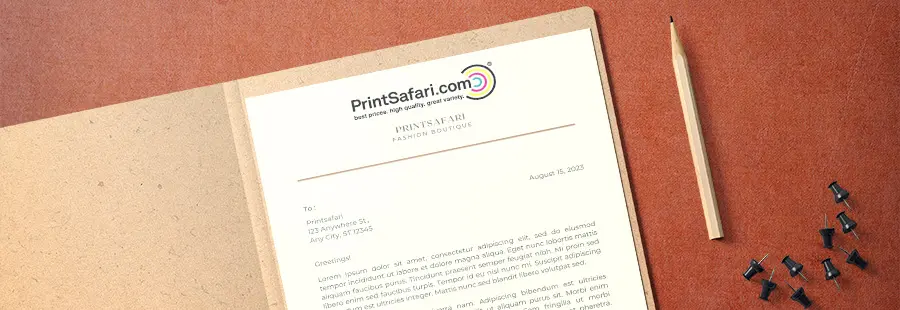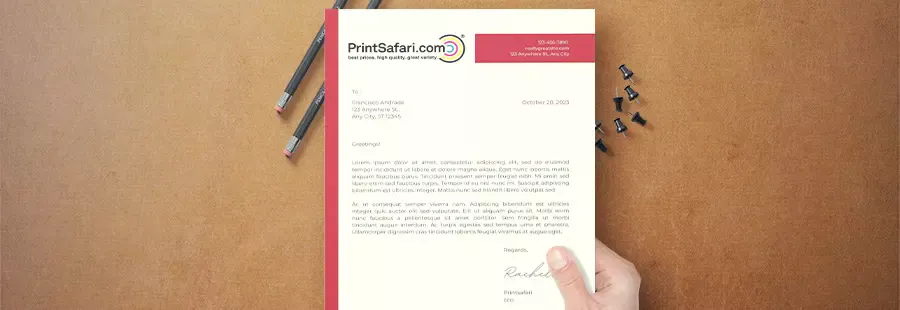How to create a letterhead in 5 minutes?
A professional Letterhead printing design gives your business correspondence a polished and trustworthy appearance. A typical letterhead includes your company’s name, logo, address, and essential contact details like phone number, email address, and website, making it easy for recipients to recognize and reach you.

What does a letterhead serve?
Utilizing letterhead will:
- Contact potential customers
- Corporate contract templates that you can brand
- Send or print a cover letter for a job application
- Creating invoices
- Get a law firm’s legal documents ready
- Keep meeting minutes and send personal letters
- Contact potential customers
This article will describe how to create letterhead using a Word template or document and what professional-quality letterhead should look like.
Describe a letterhead
Letterhead is used to identify the business or person sending the communication formally and typically includes the following information:
- Name/Company name
- Address
- Contact Information
- Inbox address
- Logo and graphics
A mission statement or tagline may occasionally be included on a professional letterhead, depending on the business and individual.
Why is using a letterhead necessary?
Letterhead is a crucial component of effective communication because it immediately identifies the sender and provides contact information that is simple to find.
Make a letterhead in Word: Instructions.
You can create letterhead that is of professional quality using several techniques. In this section, we’ll look at a few ways to design your letterhead using Microsoft Word. (Indeed is not affiliated with any companies mentioned in this article.)
Using free Microsoft Word letterhead templates
Utilizing a business letterhead template, create your letterhead by following these three steps.
1. Select a letterhead design
Searching the template database of Microsoft Word is the first step in creating a letterhead using one of the program’s templates. Microsoft Word should open with a list of the most widely used templates.
All templates offered by the application can be found by typing “business letterhead templates” into the template search bar. If none of the options there appeal, you can visit create.microsoft.com to discover even more choices.
2. Personalize it with your details
Open the template you’ve selected as a new Word document. After that, you can start personalizing the template with your data. The sender’s full name, phone number, and postal or email address are typically included on letterheads.
Below your name, you can also list any credentials or professional titles. After entering your data, you can tweak the font size or color scheme until you are happy with the layout.
Store it on your computer
You can save your letterhead to your hard drive once it is finished. You can select “Save as” to save your letterhead as a template after clicking “File.” You can then easily access and modify your letterhead, thanks to this. A searchable file name, such as “Professional letterhead template” or “Letterhead” (+ the current year) should be given to the document.

Using a Microsoft Word document
You can create your letterhead without a template by following these seven steps.
Sample letterhead
Sketch your design on paper
If you cannot find a template you like or would like to show off your creative skills, you can create a letterhead using an empty Microsoft document. It is a good idea to start by sketching a rough draft of your design on paper. Include all the necessary information and leave room for a personal logo or photo.
A new document should be opened and saved as a Business letterhead template.
Then, click “Save as” to save a new Word document to your template folder. You’ll be able to find, edit, and reuse your letterhead template in the future in this way. Give your template a name you’ll remember and can easily search for.
Put a header in
Open the document, then select “Insert” from the page’s top menu. Select “Header” from the list below to add a header to your document. Once the title has been added, start typing by clicking inside it.
Text to enter
The next step is to enter all of your contact details. Your name, address, phone number, email address, and other pertinent information should be included. Each line of text can be stacked using the “Enter” key.
You can change the font size after all the information has been typed. Your name should typically be two font points bigger than the other text. The most crucial information mentioned on your official letterhead can also stand out by using different font colors.
Add more design components.
Once your text has been entered correctly, you can consider other design components. You can put your letterhead in a box or add a line underneath to make it stand out from the rest of the document. You could also surround your stationery with essential components like geometric shapes or patterns. Remember that your design aims to highlight your contact information, so do not overwhelm your letterhead with too many intricate elements. You can see free letterhead examples to have an idea.
Think of a footer
You can also include a footer using your letter’s “Insert” option. With content at the bottom of your letter, footers are a visually appealing way to balance the design. The header’s color scheme, design elements, and a combination of a company or person’s name, logo, and tagline are typically used in the footer.
Save for quick access
You must save your corporate letterhead to your hard drive after being satisfied. If you save it as a template, it will be simple to find and edit whenever necessary. To make it simple to share the document online, you can save it as a PDF.

Advice on creating letterhead
Here are some more ideas on how to create an effective letterhead:
Play around with various software
You can use more sophisticated programs like Adobe InDesign, Photoshop, or Illustrator in addition to Microsoft Word. Although these programs cost more, they give users more options for producing distinctive visual elements.
Maintain coherence
Maintaining a theme is paramount when it comes to graphic design. Keep the number of fonts on your letterhead to two or three, and stick to a small color palette. Your design will be more appealing the more cohesive it is.
Know who they are
Think about the audience for your business letterheads. Keep your design straightforward and brief if you’re sending a cover letter to a formal company. Use more vibrant colors and entertaining fonts if you write to a tech start-up known for its laid-back workplace.
Format your paper correctly.
Make sure your document is the proper size for printing if you are creating letterhead from scratch. In the US, this usually means setting up your document in the typical 8.5 x 11 letter size.
Margin: proper format.
Letterheads are typically 8.5″ x 11″ in size and are printed on the top or bottom of a business document. Your business letterhead should also have bottom and side margins of 1/4″ and be at least 0.8″ from the top of the page.
Fonts

Before selecting a font, decide on your company’s branding aesthetic. Then, change the fonts, colors, and sizes for this theme. Futura, Helvetica, and Century Gothic are typical examples of bold fonts businesses use because they are great at drawing attention. But make sure your company letterhead stands out by experimenting with standard fonts or designing your font.
Company Name
Your company name should be at least two points larger than other information on the letterhead, such as your phone number, fax number, and email address, since it will be one of the letterhead’s main focal points. To match the hues of your logo, you can also use a different font color for your company name.
Company’s logo
Your company logo is typically placed in a business document’s right or left-hand corner. Place your general information on the opposite side for a cleaner appearance and ensure the area around the logo is not crowded. You can search for a company letterhead template.
Business-related data
Your company name, logo, address, phone number, and email address should all appear on your business letterhead. You can omit this information if your logo has a website or email address. You can add your name, last name, position, and other personal information to make your business letterhead more distinctive.
Include links to each social media platform if your company has accounts there. Links to a company’s Facebook, Twitter, and LinkedIn accounts are typically added. You can increase your online presence by doing this.
Receiving a letter on plain paper versus an attractive letterhead makes a significant difference. A letterhead serves as a marketing opportunity, offers a chance for brand engagement, and, above all else, gives the words on the page credibility.
Making a letterhead that works well is a difficult task. Sometimes a customer will interact with your letterhead design for the first time, while other times, it will be used to reinforce the brand identity. Paying attention to the details is essential while creating something striking and memorable. In our post about letterhead design, see beautiful examples.
Design with hierarchy
Effective communication of crucial information is at the heart of letterhead design, as in virtually every other design area. The company or individual writing the letter is typically (but not always) the most critical information you need to convey. After that, you’ll need a return address, a phone number, or an email address, though these are not quite as crucial as the business name. Unless they are?
You must choose the essential information your letterhead should convey and base your design on this hierarchy. While less critical information can be shrunk in size and hidden in a less prominent location, essential information should be placed prominently and easily accessible.
Use the appropriate software.
Although it is possible to create a letterhead using Photoshop, far more effective tools are available. Photoshop is sometimes a helpful design tool.
Illustrator and InDesign are at the top of the list. These programs are vector-based and have excellent typography controls, making drawing specific elements more straightforward and effectively repositioning them.
Remember that print-destined artwork should be created at 300 dpi if you only have Photoshop. If you print your letterheads commercially, there will be a bleed requirement (consult your print supplier).
Simple is best
Keeping the design as simple as possible is one of the fundamental principles of an effective letterhead. Remember that a paper is merely a means of delivery. Your stationery should feel and look great, but the design should allow the letter’s content to be printed over it.
Use your design to highlight the content without a doubt, but don’t fight the reader’s attention for it. If you’re unsure whether your letterhead design competes with the content, asking yourself that question is helpful.

Display the Brand Logo
When creating your letterhead, carefully represent the company’s branding. This includes the color scheme, font(s), imagery, and many other elements besides the logo. Make sure to follow the exclusion zone in your logo on your le’s equally essential to use the correct font.
For The Medium Design
Letterheads were once only intended for print; after being professionally printed, they would be typed (or published) in the office. However, as paper becomes more valuable in the digital age, many letterhead designs will only ever be printed on an office printer – either directly using a Word template or something similar.
Knowing how your letterhead design will be used is crucial because it makes little sense to design a full-page bleed if your office printer won’t print to the edge of the sheet. Instead, use wide margins at the page’s edge if you’re designing for a self-print solution, and stay away from highly light tints that might not reproduce appropriately on office equipment.
Pick the Appropriate Details
On a letterhead, it’s not always necessary to include every detail. Take into account who will be using the stationery. Perhaps it makes sense to have a direct dial to the managing director’s secretary’s office if it is intended solely for them and will only ever be used by them. Choose a general number instead if the stock will be used for various applications.
Information such as registration numbers for accrediting organizations like Companies, House, or The Charity Commission may be required by law to be included. Beyond those specifications, however, consider the required information and pick the appropriate information for your letterhead.
Introduce special effects
If you’re having your letterheads printed by a pro, consider the special effects you can use to give your design a more lustrous appearance.
Printing a spot-UV design over a solid color letterhead reverse that will reflect light differently from the UV-printed areas is an easy way to add sophistication to your design. This effect has a low cost but a striking appearance.
Other options include using a specialized printer for foil blocking, die-cutting, and letterpress effects (embossing and debossing).
Sparingly use color
This principle is worth repeating because it applies to almost everything you design. Color is a fantastic way to highlight your design and particular areas of your letterhead. In addition to highlighting a section, it can convey certain concepts and feelings, foster associations, and support branding.
With great power comes great responsibility, and color is a potent tool that can make or break your letterhead design.
Think about the placement and alignment.
Utilize the letterhead’s size and shape to help you decide where to place specific elements. Remember that your letterhead design should relate your branding to the medium.
Consider indenting the logo half its icon width from the edge of a standard A4 portrait letterhead for illustration. Shape and offset should be balanced to create a connected design to help your design stand out on the page.
Take advantage of stock Characteristics
Many excellent paper stocks are available from companies like GF Smith if you’re designing for print (opens in new tab). Each has distinct qualities; some are smooth and heavyweight, while others have a rich, textured surface.
Utilizing stock selection during the letterhead design process can aid in securing your artwork in its new location and create something aesthetically pleasing on both the tactile and visual levels.
A 320gsm card letterhead is useless if your client’s office printer can’t handle that stock weight, so remember the need for practical application!








